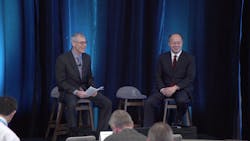Keynote Discussion: A conversation with John Lee, CEO, MKS Instruments
One of the unique opportunities of the Lasers & Photonics Marketplace Seminar is to gain insights from exclusive conversations with leading figures of the photonics community. John T. C. Lee, President and CEO of MKS Instruments, is such a person and he shared a lot of his perceptions and ideas with the audience in a 50-minute conversation with John Lewis, Editor in Chief of Laser Focus World (see figure).
Founded in 1961, MKS Instruments started with a single product—a capacitance manometer—that measures true gas pressure for semiconductor applications. They expanded their business and with the acquisition of Newport Corporation in 2016, they added lasers, photonics, and optics solutions to their portfolio. In 2019, they purchased ESI, a longstanding producer of laser-based manufacturing systems for the electronics industry. In total, MKS has conducted 15 acquisitions since 2000 and currently a staff of more than 5000.
With experiences in the semiconductor and photonics industries, Lee is well positioned for a comparison of both worlds. It turns out that the consolidation process in the semiconductor world is more advanced, as only a handful of companies have survived from the approximately 30 chipmakers serving the market 30 years ago.
Lee saw the size of R&D budgets as a critical trigger for such a consolidation. “Consolidation only makes sense if the industry is solving more complex problems,” Lee said, and “as problems become more complex, they require companies with larger R&D budgets that can sustain the kind of R&D required to solve those complex problems.” He did not expand on the current complexity within the photonics industry. But the history of EUV lithography may well serve as an example, confirming this idea.
Another lesson to learn from the semiconductor industry might be the ability to survive in a highly cyclical business. Good partnerships with suppliers are an essential strategic advantage for Lee: “You need partners who will stay with you in the downturn, and you need partners who will invest and ramp with you in the upturns. We had to treat … suppliers as partners, and so we take that to every partner, every supplier that we have now.”
This becomes particularly important, as Lee has an ambitious growth strategy. MKS had $700 million in revenue and 2000 employees in 2015, and by 2019, they were at $2 billion in revenue and 5000 employees. Going towards 3 billion or even 5 billion in revenue within the upcoming years appears feasible; that could include upwards of some 12,000 people. Lee’s main concern is about the latter: “What really keeps me up at night is trying to figure out how to sustain and celebrate our culture of inclusion.”
Caring for the people becomes particularly challenging if a problem such as the COVID-19 virus hits the industry. Asked for his measures to react to this situation, Lee explained some of their activities: “We meet daily… All the senior executives, as well as our executives on the ground in Asia.” Their first priorities are the employees, their safety, and whereabouts, especially since many people are traveling for the Chinese New Year holidays. Then, they focus on communications—internally, with suppliers, and with customers, to mitigate issues within the supply chain and customer deliveries. Overall, MKS has bright future under its new leader and the photonics industry should benefit from MKS’ participation.
CONTINUE READING >>>
DOWNLOAD FULL REPORT

Andreas Thoss | Contributing Editor, Germany
Andreas Thoss is the Managing Director of THOSS Media (Berlin) and has many years of experience in photonics-related research, publishing, marketing, and public relations. He worked with John Wiley & Sons until 2010, when he founded THOSS Media. In 2012, he founded the scientific journal Advanced Optical Technologies. His university research focused on ultrashort and ultra-intense laser pulses, and he holds several patents.
